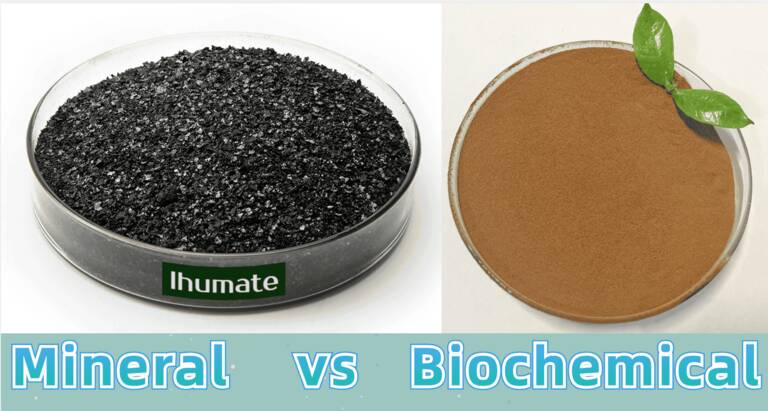Understanding the Differences and Connections Between Mineral and Biochemical Fulvic Acid
Fulvic acid is emerging as an important supplement for soil and plant health. But not all fulvic acid products are created equal. Two main types exist on the market - mineral fulvic acid and biochemical fulvic acid. What sets them apart and which is better? This article breaks it down.In the figure below, the left side is our company's potassium fulvic acid, and the right side is biochemical fulvic acid

Mineral Fulvic Acid Overview
Mineral fulvic acid is extracted from decomposed ancient plant deposits like lignite, leonardite, and peat. It forms through microbial and chemical transformation of organic residues over millions of years. Therefore, it usually appears black or dark brown
Mineral fulvic acid contains a diverse array of organic acids and functional groups like carboxyls, phenols, ketones, and alcohols. These enable it to effectively chelate positively charged mineral nutrients like calcium, magnesium, and potassium.
The small molecular size of fulvic acid also allows it to readily enter plant tissues. This supports its role as an efficient mineral transporter.
Overall, mineral fulvic acid enhances soil fertility and structure. It’s also highly bioavailable to plants and can be applied through both soil and foliar routes.
Biochemical Fulvic Acid Overview
In contrast to ancient origins, biochemical fulvic acid is synthetically produced from modern organic materials. Common sources include crop residues, paper mill waste, molasses, and yeast extracts.So it is generally yellow
The production process involves acid hydrolysis and extraction to isolate fulvic-like fractions from the organic matter. However, biochemical fulvic acid tends to have less diversity of functional groups compared to ancient mineral deposits.
Biochemical fulvic acid also contains more polysaccharides, proteins, and lignin. Its unique chemical makeup gives it high moisture absorption capacity.
Though biochemical fulvic acid can enhance soil properties, its effects are generally less pronounced than mineral varieties. It also has some handling challenges due to its sticky texture.
Four Key Differences
Though both can improve soil, there are several major differences between mineral and biochemical fulvic acid products:
1. Sources
Mineral fulvic acid derives from prehistoric plant deposits like lignite. Biochemical fulvic acid comes from modern organic agricultural and industrial wastes.
2. Composition
Mineral fulvic acid boasts more types of active organic acids and functional groups. Biochemical fulvic acid contains fewer functional groups and more polysaccharides and lignin.
3. Dosage
Mineral fulvic acid is highly active at low doses. Biochemical varieties require much greater application rates to achieve similar effects.
4. Performance
Mineral fulvic acid demonstrates stronger benefits for soil fertility, plant growth, and yield. Biochemical types tend to show weaker effects overall.
Key Benefits of Mineral Fulvic Acid
The unique properties of mineral fulvic acid make it advantageous for many applications:
- Chelates and transports nutrients to plants
- Improves soil aggregate structure
- Stimulates microbial activity
- Enhances root growth
- Increases cell wall permeability
- Is effective in foliar sprays
- Has high organic matter content
These benefits enhance soil health and plant performance. Mineral fulvic acid is especially helpful for overcoming mineral deficiencies and improving yields.
Is Biochemical Fulvic Acid Useless?
Though less potent than mineral varieties, biochemical fulvic acid can still offer value:
- Improves moisture retention
- Supplies organic matter
- Chelates some minerals
- Can be produced sustainably from waste
For very poor or depleted soils, biochemical fulvic acid provides a cost-effective way to boost organic matter. It also avoids depletion of limited mineral deposits.
However, mineral fulvic acid remains a superior choice for most applications due to its greater biological activity and efficiency.
Conclusion
When it comes to fulvic acid supplements, mineral sources derived from ancient organic deposits are vastly superior to biochemical products made from modern waste materials.
The complex mixture of organic acids and antioxidants in mineral fulvic acid cannot easily be replicated through synthetic production methods. It offers unmatched benefits for soil conditioning, plant nutrition, microbial balance, and more.
For best results, choose a mineral fulvic acid product extracted from leonardite or lignite. It will contain the highest concentration of biologically active organic compounds to enhance soil and stimulate plant growth.
Though more expensive than biochemical varieties, a little mineral fulvic acid goes a long way. Follow label instructions for application rates. For most soils, regular use of quality mineral fulvic acid can profoundly improve fertility, yield, and plant hea
